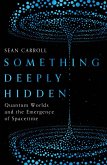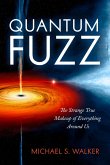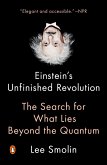The fascinating story of how quantum mechanics went mainstream.
The discovery of the quantum -the idea, born in the early 1900s in a remote corner of physics, that energy comes in finite packets instead of infinitely divisible quantities - planted a rich set of metaphors in the popular imagination.
Quantum imagery and language now bombard us like an endless stream of photons. Phrases such as multiverses, quantum leaps, alternate universes, the uncertainty principle, and Schrödinger's cat get reinvented continually in cartoons and movies, coffee mugs and T-shirts, and fiction and philosophy, reinterpreted by each new generation of artists and writers.
Is a 'quantum leap' big or small? How uncertain is the uncertainty principle? Is this barrage of quantum vocabulary pretentious and wacky, or a fundamental shift in the way we think?
All the above, say Robert P. Crease and Alfred Scharff Goldhaber in this pathbreaking book. The authors - one a philosopher, the other a physicist -draw on their training and six years of co-teaching to dramatize the quantum's rocky path from scientific theory to public understanding. Together, they and their students explored missteps and mistranslations, jokes and gibberish, of public discussion about the quantum. Their book explores the quantum's manifestations in everything from art and sculpture to the prose of John Updike and David Foster Wallace. The authors reveal the quantum's implications for knowledge, metaphor, intellectual exchange, and the contemporary world. Understanding and appreciating quantum language and imagery, and recognizing its misuse, is part of what it means to be an educated person today.
The result is a celebration of language at the interface of physics and culture, perfect for anyone drawn to the infinite variety of ideas.
The discovery of the quantum -the idea, born in the early 1900s in a remote corner of physics, that energy comes in finite packets instead of infinitely divisible quantities - planted a rich set of metaphors in the popular imagination.
Quantum imagery and language now bombard us like an endless stream of photons. Phrases such as multiverses, quantum leaps, alternate universes, the uncertainty principle, and Schrödinger's cat get reinvented continually in cartoons and movies, coffee mugs and T-shirts, and fiction and philosophy, reinterpreted by each new generation of artists and writers.
Is a 'quantum leap' big or small? How uncertain is the uncertainty principle? Is this barrage of quantum vocabulary pretentious and wacky, or a fundamental shift in the way we think?
All the above, say Robert P. Crease and Alfred Scharff Goldhaber in this pathbreaking book. The authors - one a philosopher, the other a physicist -draw on their training and six years of co-teaching to dramatize the quantum's rocky path from scientific theory to public understanding. Together, they and their students explored missteps and mistranslations, jokes and gibberish, of public discussion about the quantum. Their book explores the quantum's manifestations in everything from art and sculpture to the prose of John Updike and David Foster Wallace. The authors reveal the quantum's implications for knowledge, metaphor, intellectual exchange, and the contemporary world. Understanding and appreciating quantum language and imagery, and recognizing its misuse, is part of what it means to be an educated person today.
The result is a celebration of language at the interface of physics and culture, perfect for anyone drawn to the infinite variety of ideas.








